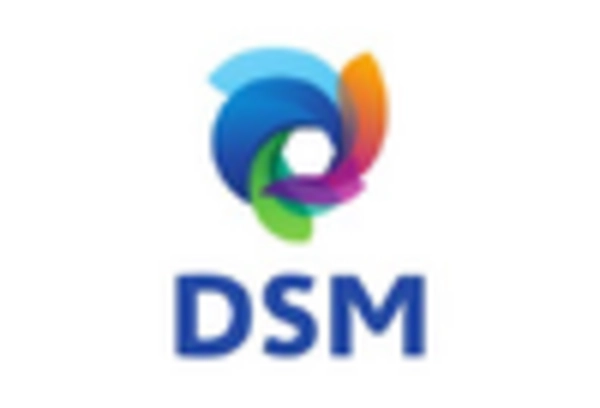The Bioactive Material Market is currently characterized by a dynamic competitive landscape, driven by innovation, sustainability, and strategic partnerships. Key players such as BASF SE (Germany), Dow Inc. (US), and Evonik Industries AG (Germany) are actively shaping the market through their distinct operational focuses. BASF SE (Germany) emphasizes innovation in biopolymers, aiming to enhance product performance while reducing environmental impact. Dow Inc. (US) is concentrating on expanding its portfolio of bio-based materials, aligning with global sustainability trends. Meanwhile, Evonik Industries AG (Germany) is leveraging its expertise in specialty chemicals to develop bioactive materials that cater to the healthcare sector, thus diversifying its market reach. Collectively, these strategies indicate a shift towards more sustainable and innovative solutions, intensifying competition within the market.
In terms of business tactics, companies are increasingly localizing manufacturing to enhance supply chain resilience and reduce lead times. This approach appears to be a response to the growing demand for bioactive materials across various industries, including healthcare, food, and cosmetics. The market structure is moderately fragmented, with several key players exerting considerable influence. The collective actions of these companies suggest a trend towards consolidation, as they seek to optimize their operations and expand their market presence.
In August 2025, BASF SE (Germany) announced a strategic partnership with a leading biotechnology firm to co-develop bioactive materials aimed at the pharmaceutical industry. This collaboration is expected to accelerate the development of innovative solutions that address specific healthcare needs, thereby enhancing BASF's competitive positioning in a rapidly evolving market. The partnership underscores the importance of collaboration in driving innovation and meeting the increasing demand for specialized bioactive materials.
In September 2025, Dow Inc. (US) launched a new line of bio-based polymers designed for use in packaging applications. This initiative not only aligns with the company's sustainability goals but also positions Dow as a leader in the bioactive materials segment. The introduction of these products is likely to attract environmentally conscious consumers and businesses, further solidifying Dow's market presence.
In October 2025, Evonik Industries AG (Germany) unveiled a new bioactive material specifically designed for wound care applications. This product launch reflects Evonik's commitment to advancing healthcare solutions and highlights its strategic focus on the growing demand for innovative medical materials. The introduction of this bioactive material is expected to enhance patient outcomes and strengthen Evonik's foothold in the healthcare market.
As of October 2025, the Bioactive Material Market is witnessing significant trends such as digitalization, sustainability, and the integration of artificial intelligence in product development. Strategic alliances are increasingly shaping the competitive landscape, enabling companies to pool resources and expertise to drive innovation. Looking ahead, competitive differentiation is likely to evolve, with a pronounced shift from price-based competition to a focus on innovation, technological advancements, and supply chain reliability. This transition suggests that companies that prioritize these aspects will be better positioned to thrive in the future.

















Leave a Comment